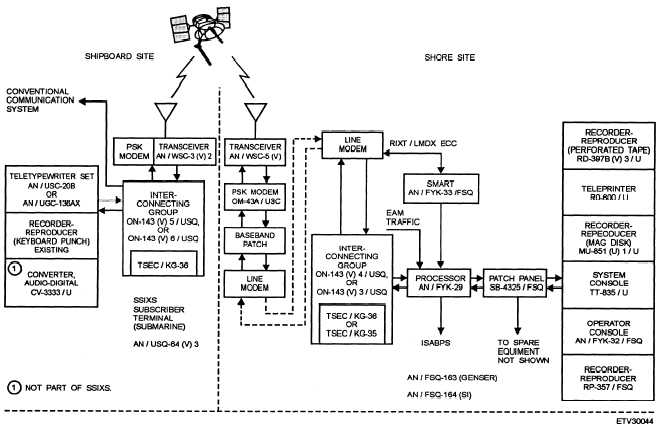communications. These improvements help increase
message traffic through-put rates and traffic volume,
and improve link reliability. Figure 3-5 shows both
sides of the CUDIXS/NAVMACS subsystem.
Message Traffic Input
At shore facilities, the primary collection point
for message traffic to be transmitted or received on
the CUDIXS/NAVMACS rf link is NAV-
SUBMARINE SATELLITE
INFORMATION EXCHANGE
SUBSYSTEM (NON-DAMA)
SSIXS was designed to compliment vlf and mf/hf
communication links between shorebased submarine
broadcast control authorities (BCAs) and submarines.
Figure 3-6 shows a SSIXS subsystem.
This subsystem provides the submarine
commander the ability to receive messages transmitted
via satellite at scheduled intervals ( “ G r o up
Broadcasts”). Between Group Broadcasts,
submarines may transmit messages to the BCA,
including a request for messages held in queue. The
shore terminal responds with acknowledgements for
the received messages and transmits all messages
addressed to that particular submarine. Two modes,
Group Broadcast and Query/Response, permit the
submarine to be active or passive, depending on what
the submarine commander wants. One 25-kHz
wideband channel on each of the four FLTSATCOM
satellites has been allotted to SSIXS. A single SSIXS
network may have up to 120 submarine subscribers.
COMPARS.
Rf transmission Link Control (Non-DAMA)
The CUDIXS baseband equipment shares a
common rf terminal with other subsystems. At the
shore facilities this terminal is a uhf transceiver,
AN/WSC-5(V). Aboard ship, NAVMACS uses a uhf
transceiver, AN/WSC-3(V). All uhf satellites have 25-
kHz-wide channels allocated for CUDIXS/
NAVMACS transmissions. Each channel is operated
as a half-duplex uhf link, with a data transmission rate
of 2400 bps. The rf modulation is differential encoded
phase-shift keying (DPSK).
Figure 3-6.—SSIXS subsystem.
3-9


